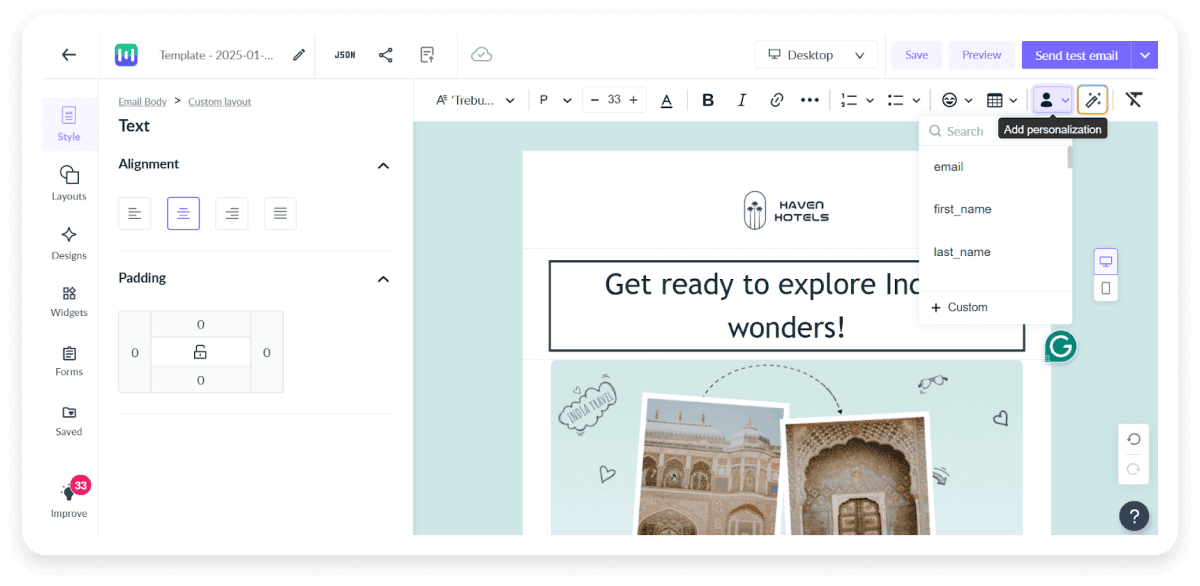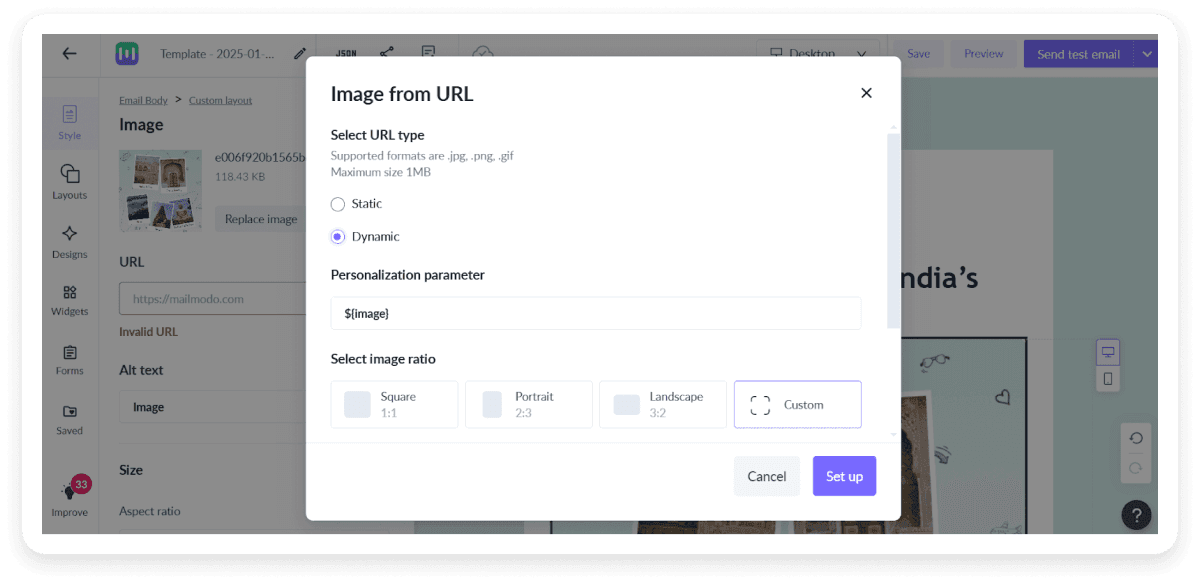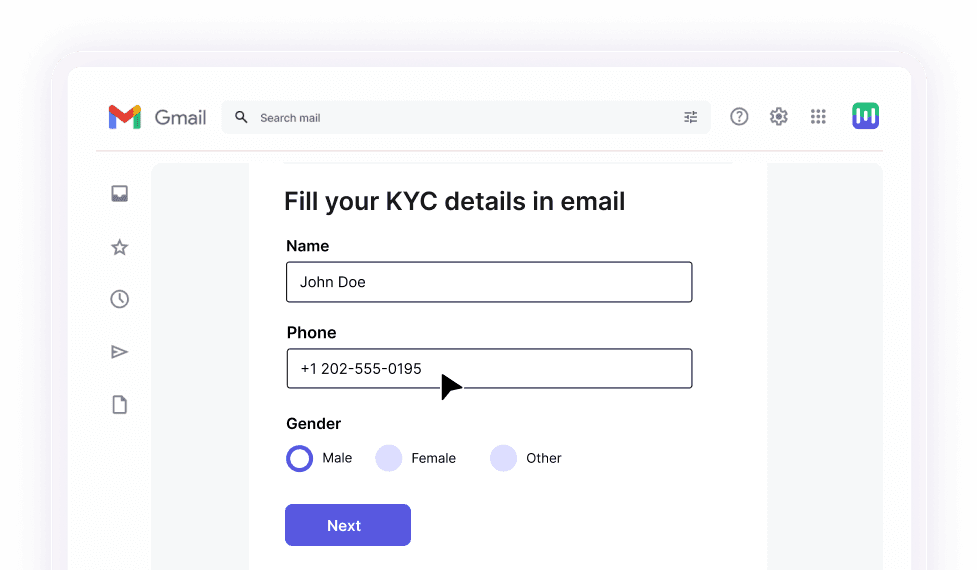What is email personalization?
Email personalization is a strategy where emails are tailored to cater to individual recipients based on their behavior, preferences, and interaction history. By leveraging data such as browsing activity, past purchases, and engagement patterns, businesses can craft messages that feel relevant and personal rather than generic.
This approach enhances customer experience, increases engagement, and drives conversions.
Imagine a customer browses winter jackets during a holiday sale but doesn’t complete a purchase. You can send a trigger email featuring the same jackets, along with complementary product recommendations like scarves or boots. This targeted approach increases the likelihood of a purchase while enhancing the shopping experience.
Why should you personalize your emails?
Here are some of the reasons why email personalization is a requirement:
1. Audience demands personalization
Modern consumers expect brands to understand their needs and preferences. Generic emails often get ignored, while personalized messages create a stronger connection. The statistics below highlight why personalized email marketing is no longer optional. It's essential for building lasting customer relationships and driving conversions.
60% of consumers say they will likely become repeat buyers after a personalized shopping experience with a retailer. - Segment, The State of Personalization 2021
When an email lacks personalization, 52% of customers say they will choose a different place to shop. - Activetrail
70% of millennials are frustrated with brands sending irrelevant emails. - SmarterHQ
2. Generates higher engagements
Personalized emails are tailored to users' behavior, preferences, and other aspects, offering more relevant and valuable content than mass emails. Emails with personalized subject lines and content stand out in crowded inboxes, leading to better open and click-through rates.
Due to increased relevancy, 57% of marketers say they have achieved better visitor engagement due to email personalization.
3. Reduces unsubscribe rate and enhances user retention
Users feel happy and contented when they get relevant emails they like and want to receive. They do not feel like you are bombarding them with unnecessary sales emails. Such understanding creates mutual trust and loyalty, which leads to better user retention. As a result, less users unsubscribe.
4. Gives you a competitive advantage
If you personalize your emails, congratulations! You are among 55% of marketers who prioritize personalizing their email programs.
Brands that fail to personalize risk falling behind, while those that do gain a significant competitive advantage—turning data into deeper customer connections and higher engagement.
Tiers of email personalization
Personalization in opt-in email marketing can be categorized into different tiers based on complexity and depth. Here’s a breakdown of the key tiers:
1. Basic personalization
This simplest personalization form involves minor tweaks to make emails feel more personal. This tier personalizes emails based on characteristics like age, gender, occupation, or interests.
First-name personalization: Adding the subscriber’s name in the subject line or email body (e.g., “Hi X, check out these new arrivals!”).
Location-based personalization: Including location-specific details like weather updates or nearby store offers.
Age or gender-based recommendations: Suggesting products relevant to specific demographics (e.g., “Trending sneakers for women”).
2. Behavioral personalization
Based on different customer behaviors, you can personalize emails to enhance engagement and drive conversions. Past activities such as purchase history, browsing behavior, and cart interactions provide valuable insights into customer intent.
For example, if a customer frequently purchases skincare products but hasn’t tried a newly launched serum, you can send a personalized email introducing the product, highlighting its benefits, and possibly including a first-time discount.
Similarly, if a subscriber consistently engages with your emails but hasn’t made a purchase, a targeted email featuring bestsellers or limited-time offers can encourage them to take action.
For loyal customers who regularly shop with you, a VIP appreciation email with exclusive perks, early access to sales, or loyalty rewards can strengthen brand affinity.
By progressing through these tiers, businesses can create highly engaging and effective email campaigns that build stronger relationships with subscribers.
How to create personalized emails

The users' data drive personalization. So, the first step is to collect the data. After collecting the data, you must analyze it and create various segments.
Step 1: Collect user data
To give a personalized experience to your subscribers, you require their information. Data is that pillar without which personalization can't exist. But how do you gather this data? There are many ways you can use such as:
Ask users about their preferences, interests, and pain points via feedback forms, surveys, and polls.
Set up a preference center to let users tell you what kind of content they prefer.
Use your ESP's analytics to track user interaction with your email campaigns.
Track user interactions on your website using third-party tools like Google analytics.
What kinds of data should you collect?

You can collect four kinds of customer data for personalizing email content:
1. User attributes
User attributes define who your customers are. It includes basic details that shape their identities, such as their
Attributes give you a holistic view of your customers and serve as a great starting point for dynamic personalization and segmentation.
2. Event data
Event data is activity-based information about your customers. Events tell a story about how your users interact and engage with your brand, giving you a greater understanding of their changing interests and preferences over time.
Event data gives you a multidimensional view of your customers' behavior throughout their journey so you can send relevant content.
3. Data feeds
A data feed refers to a continuous stream of data that is automatically delivered or updated, often in real-time. It comes from an external source and can be used to update or feed dynamic content into your emails or website. Examples include live inventory updates, dynamic pricing, trending products etc.
4. Metadata
Metadata refers to data that provides information about other data. In the context of email marketing, metadata is used to describe and track various aspects of user behavior and email interactions. Examples include tracking how many times a user has opened an email, clicked on a link, or unsubscribed.
Metadata helps in segmenting users and sending them tailored content based on their actions, preferences, or engagement history.
Step 2: Segment users based on data you've collected
Segmentation is the next step on the ladder, which leads to personalization. It helps you shift from - telling your whole email list, Hey! We launched a new product 🎉 to tell those interested and need to hear about the launch.
This way, you can ensure that interested users get more personalized one-to-one communication valuable to them.
Step 3: Create personalized emails
It's time to make personalized emails. So, what are you going to personalize?
There is no limit to how and what you can personalize.
Creating personalized emails enhances engagement and strengthens customer relationships. By utilizing Artificial Intelligence (AI) and Machine Learning (ML), you can tailor various elements of your emails to individual preferences.
What can you personalize in an email?
Subject lines: Dynamic subject lines that include names, preferences, or past actions.
Email content: Customized product recommendations, special offers, or event invitations based on past behavior.
Images and banners: Personalized visuals reflecting user interests or recent interactions.
Call-to-action (CTA): Contextual CTAs tailored to the recipient’s journey.
Role of Artificial intelligence (AI) and Machine Learning (ML) in creating personalized emails
AI and ML have transformed email personalization by allowing brands to deliver highly relevant, data-driven, and engaging content at scale. Unlike humans, AI can analyze vast amounts of customer data from multiple sources—CRM tools, website interactions, and email engagement metrics—uncovering deeper insights and patterns. Machine learning algorithms process this data to generate actionable insights, predict customer preferences, and determine the most effective messaging for each subscriber.
Besides, ML and AI also help assess your audience's behavior, create common behavioral patterns, and predict their future behavior and offer recommendations and content that will resonate with them.
A great example is Netflix which uses behavioral analysis to assess the user's past viewing history and send them movie recommendations based on that. If you have subscribed to Netflix's newsletter, you'll see how personalized and persuasive they are.
Using AI-powered tools like Kick Dynamics, Persado, and Phrasee can be an effective strategy for this sort of personalization. It can boost your open rate and customer engagement.
Email personalization best practices
Here are some tips that we have curated for your personalized email marketing journey:
Use the recipient’s name smartly. Include the subscriber’s name in the subject line or greeting but avoid overuse to keep it natural.
Use preference centers to collect first-party data and insights into recipient preferences.
Leverage dynamic content and use personalized product recommendations, location-based offers, or past interaction history to tailor the email experience.
If you're using dynamic images, always add a fallback version if the recipient's email client doesn't support the images.
Experiment with different personalization techniques using A/B testing, such as subject lines, images, and content, to see what resonates best with your audience.
How to personalize emails in Mailmodo
Email personalization is crucial and becoming a necessity for a good customer experience rather than merely a trend. So, if you want to hop on this bandwagon, you need the right tool.
Enter Mailmodo!
Mailmodo is an all-around ESP that helps you design personalized emails. Here are some ways you can personalize your emails using Mailmodo.
1. Personalize using user properties
You can choose from different personalized parameters we offer, including personalized subject line, subscriber's first name, customer ID, contact number, location, etc., as shown in the image:

Learn more about personalizing the email copy using Mailmodo
2. Make the images dynamic
A dynamic image in email marketing is a visual element that changes based on the recipient’s data, behavior, or preferences. These images can be personalized using variables such as the recipient’s name, location, past purchases, browsing history, or even real-time factors like weather or countdown timers.
When you add an image to an email template, choose the dynamic image option instead of static. You'll see the personalized parameter where you can choose from all data points.

Learn more about how to add dynamic images in Mailmodo
3. Create repeatable dynamic blocks
A repeatable block contains placeholders for different personalized elements. It will repeatedly display different information by repeating the content blocks.
To learn how to create such a block, read our help guide.
Email personalization is a journey, not a destination. Therefore, you must consistently develop ways to offer your audience value that aligns with your business goals. Mailmodo makes it easy for you to do so and scale your personalization efforts as well.
Segment users based on their behavior data for better opens
Start personalizing with Mailmodo
Email marketing personalization is a journey, not a destination.
Therefore, you must consistently develop ways of offering value to your audience that align with your business goals.
And if you want to level up your email marketing performance, you should check out AMP emails by Mailmodo.
A personalized website-like experience in your user's inbox 😃 Woahh! That's something they might not expect.
Conclusion
Email personalization is essential for building meaningful customer connections and boosting engagement. By leveraging AI, machine learning, and user data segmentation, you can create highly relevant emails that stand out in crowded inboxes.
Following best practices—such as dynamic content, personalized recommendations, and behavioral triggers—can enhance your email marketing strategy, leading to higher conversions.














